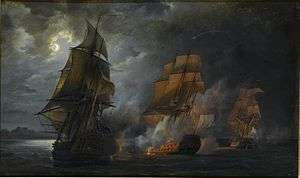HMS Jupiter (1778)
 | |
| History | |
|---|---|
| Name: | HMS Jupiter |
| Ordered: | 21 June & 1 July 1776 |
| Builder: | John Randall & Co, Rotherhithe |
| Laid down: | July 1776 |
| Launched: | 13 May 1778 |
| Completed: | By 26 July 1778 |
| Fate: | Wrecked on 10 December 1808 |
| General characteristics | |
| Class and type: | 50-gun Portland-class fourth rate |
| Tons burthen: | 1061 30⁄94 (bm) |
| Length: |
|
| Beam: | 40 ft 10 in (12.4 m) |
| Depth of hold: | 17 ft 6 in (5.3 m) |
| Propulsion: | Sails |
| Sail plan: | Full rigged ship |
| Complement: | 350 |
| Armament: | |
HMS Jupiter was a 50-gun Portland-class fourth-rate ship of the Royal Navy. She served during the American War of Independence, the French Revolutionary Wars, and the Napoleonic Wars in a career that spanned thirty years. She was also one of the fastest ships in the Royal Navy as shown by her attempt to capture the cutter Eclipse under Nathaniel Fanning.
Built in Rotherhithe, she was launched in 1778. On 1 April 1779 she assisted Delight after Delight captured the French 20-gun privateer Jean Bart.[1]
On 2 October 1779, Jupiter captured two French cutters, each of 14 guns and 120 men. The Royal Navy took both into service essentially under their existing names.[2] One was Mutin, under the command of Chevalier de Roquefeiul. She was pierced for 16 guns but carried 14, either 4 or 6-pounders. [3] The other was Pilote, under the command of Chevalier de Clonard. She carried the same armament as Mutine (or Mutin).[4] The cutters surrendered after an engagement that left Mutin dismasted.[3]
Jupiter fought at the battle of Porto Praya in 1781 and the Battle of Muizenberg in 1795, winning the battle honour 'Cape of Good Hope' for the latter. In 1799 Jupiter battled a French frigate in the aftermath of the Battle of Algoa Bay.
On 17 September 1801 she arrived at Cape Town from Rio de Janeiro, together with Hindostan and Euphrosyne, after a voyage of about a month. Lion had escorted a convoy of East Indiamen bound for China to Rio, together with Hindostan. They had arrived there on 1 August. Captain George Losack, of Jupiter, decided to accompany the convoy eastward until they were unlikely to encounter some Spanish and French vessels known to be cruising off Brazil.[5]
Jupiter shared with Diomede, Hindostan, and Braave in the capture of the Union on 27 May 1803.[6]
Fate
She was wrecked on 10 December 1808 in Vigo Bay, but all her crew were saved.
Citations
- ↑ The London Gazette: no. 11967. p. 1. 3 April 1779.
- ↑ The London Gazette: no. 12020. p. 2. 5 October 1779.
- 1 2 Demerliac (1996), p. 87, #574.
- ↑ Demerliac (1996), p.87, #573.
- ↑ Government of the Cape Colony (1899), Vol. 4, pp.76-7.
- ↑ The London Gazette: no. 15736. p. 1149. 11 September 1804.
References
- Demerliac, Alain (1996) La Marine De Louis XVI: Nomenclature Des Navires Français De 1774 À 1792. (Nice: Éditions OMEGA). ISBN 2-906381-23-3
- http://www.hmsjupiter.co.uk/history-1489.html